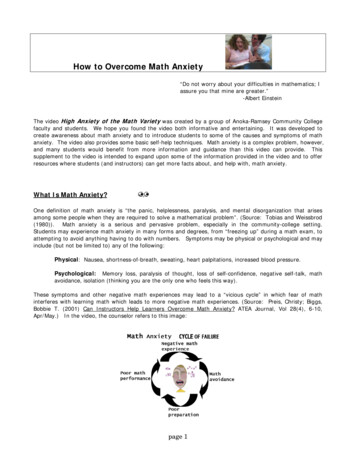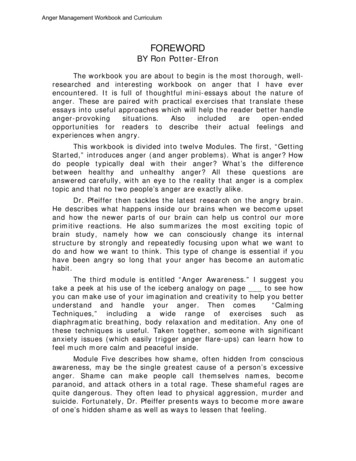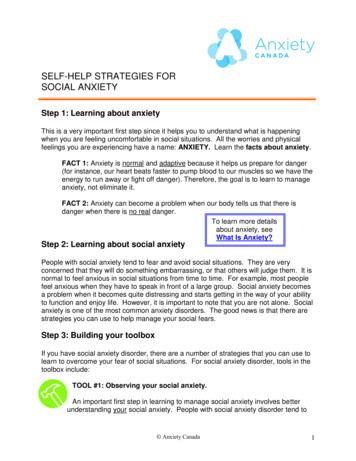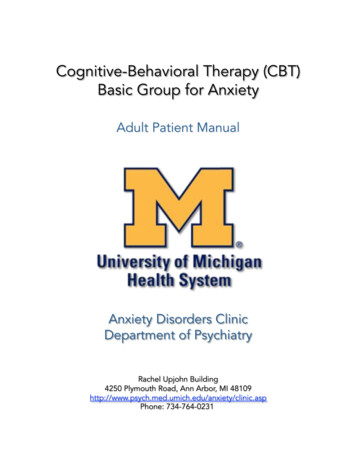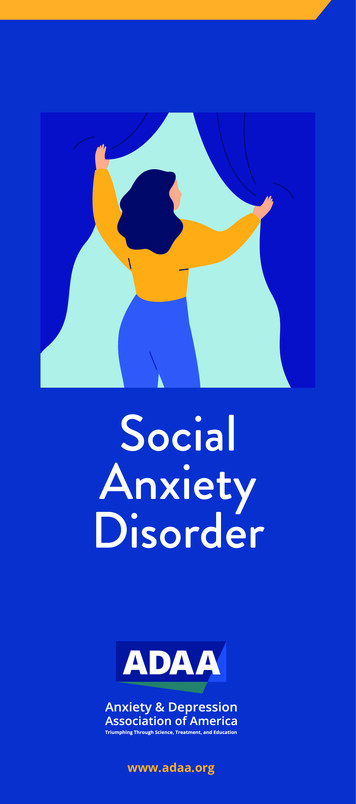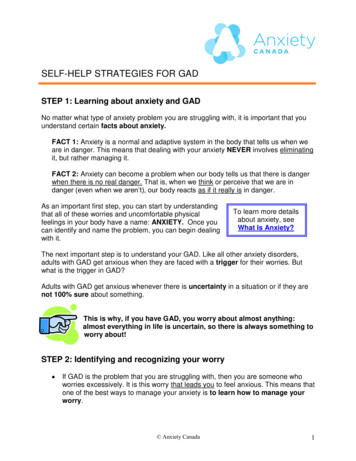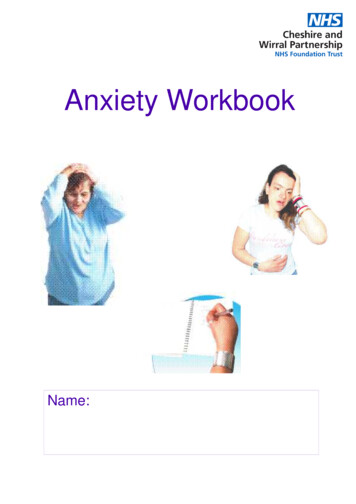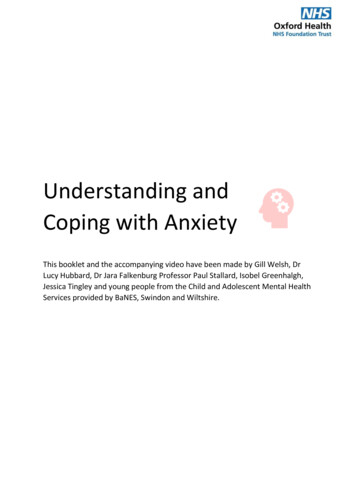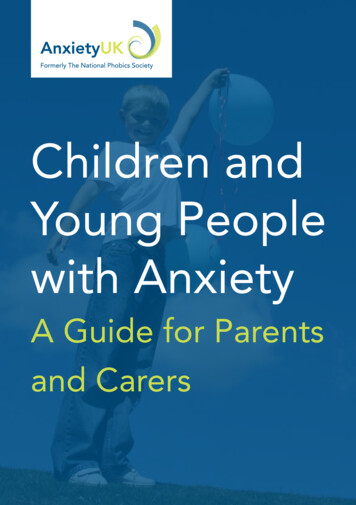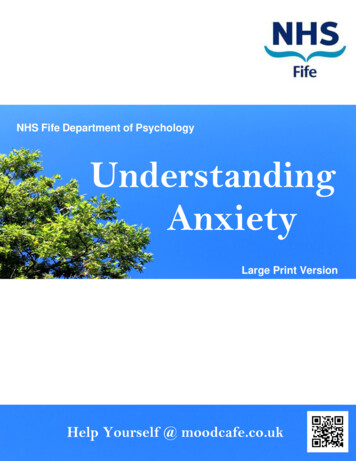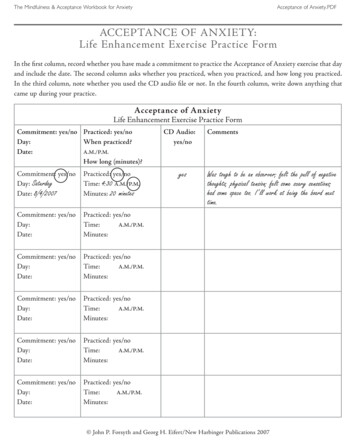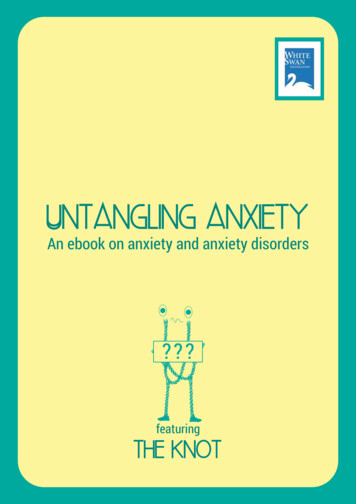
Transcription
Untangling anxietyAn ebook on anxiety and anxiety disorders?featuringthe knot
Disclaimer: Any technology platform, nutrition and exercise suggestions in thisebook should not be construed as medical advice or endorsements by White SwanFoundation. 2021 White Swan FoundationContent, design and illustration: Aditi SurendraExpert review by Dr Soumya Hegde and Dr Ashlesha Bagadia, BengaluruFirst EditionRead more about mental health, visit www.whiteswanfoundation.orgWrite to us at connect@whiteswanfoundation.org
indexIntroduction. 1What is anxiety?. 2The flight or fight response. 3What is a panic attack?. 6What is an anxiety disorder?. 10Types of anxiety disordersPhobias. 13Social anxiety. 15Panic disorder & agoraphobia. 16Generalized anxiety disorder (GAD). 17Obsessive-compulsive disorder (OCD). 20Post-traumatic stress disorder (PTSD). 22Treatment. 25How to be an ally. 27How to calm down during a panic attack. 28Extended list of anxiety symptoms. 30
introductionWe’ve all experienced anxiety, as a knot in our stomach, increased heart rate orsweaty palms. Often it passes, but sometimes it doesn’t. This ebook, UntanglingAnxiety, explains the science of anxiety; the process in the brain that causes it andwhy our bodies react to anxiety the way they do. It also elaborates on panic attacksoffering resources to calm down. The six most common types of anxiety disordershave been illustrated along with their causes, signs and symptoms.Untangling Anxiety, uses the knot we experience as a metaphor to stand in for all thedifferent ways in which we experience anxiety and through it we hope to unravel howanxiety affects our minds and bodies.The ebook aims to equip people with knowledge on anxiety so they can understandits ubiquitous nature and create a community that is friendly to those who sufferfrom anxiety disorders. Understanding how anxiety works can also greatly helpthose who suffer from it, because it demystifies the uncomfortable symptoms thatone experiences.This ebook can be useful to anyone who wants to learn about anxiety and anxietydisorders. It can aid caregivers in understanding the condition so they can empathise with their loved ones better. Psychiatrists, psychologists and other mentalhealth professionals can use it to explain anxiety and anxiety disorders to theirpatients.The ebook was created with help of Bengaluru-based psychiatrists Dr SoumyaHegde and Dr Ashlesha Bagadia.1
What is anxiety?Anxiety is how your mind and body help you cope with anything that is stressful,dangerous or unfamiliar.For example, you are about to go on stage to give a public speech.Your hands start to tremble and your legs feel like jelly. You mayhave thoughts of fear and being unprepared.While it may seem strange and uncomfortable, this is your body’s way of preparingyou to perform the task at hand. This can happen in other situations as well—whenyou’re walking down a dark street by yourself or if you are suddenly lost in anunknown city.What causes anxiety?The causes of anxiety are relative and depend on the person who is experiencingthem. We address the cause of anxiety as a ‘trigger’.A trigger is an object, concept or circumstance that causes feelings of anxiety,worry, fear or panic.If you’re in your bathroom and you spot a cockroach in acorner, you are likely to feel fear or panic. The trigger is thecockroach’s presence. You are afraid the cockroach is goingto approach you and the feelings you experience (like the rushof adrenaline) will help you escape the situation and get out ofthe bathroom without having to deal with the cockroach. Inthis example, the trigger is real and immediate.However, a trigger can also be perceived and not immediate—likeworrying about the results of a medical test. The trigger isn’t theresult, but the uncertainty of what it is and how it’s going to affectyour life. The discomfort is also anticipatory in nature as you fearwhat is going to happen. and not what is happening at themoment. It is useful because being nervous about the result canhelp you plan and prepare you for bad news if the result turns outto be unfavorable.2
The flight or fight responseBefore we built cities and social media sites, humans lived in the jungle and wereprey to many of its predators. When a person encountered a tiger in the wild, theirbody’s flight or fight response would get switched on, to help them either escape(flight) or confront (fight).The amygdala, a tiny almond-shaped part of the brain, senses the danger in theshades of orange and black behind the rustling leaves. It sends the big part of theirbrain the signal to prepare for a fight or flight—this makes the body releasehormones such as adrenaline and cortisol which cause the following reactions tooccur in the body:ReactionFlightFightHeart and lung function increasesFunctionMore oxygen reaches the brainDigestion slows down or stopsNo distractionsBladder and sphincter muscles relaxPupils get dilatedBetter eyesight and focusPeripheral vision reducesBlood pressure and blood sugar increaseGives the body energyMuscle tension increasesGives the body speed and staminaBlood flow diverted towards musclesPrevents excess bloodflow in case of an injuryBlood clotting function increases3O2
Every reaction of the fight or flight response has a purpose. For example, even ifthey were hungry before they encountered the tiger, they will not feel hungry afterbecause the body requires all of the blood flow to go towards the muscles, leavingthe digestive system unattended. Also, who wants to start to feel hungry whiletaking down a tiger?Anxiety, worry, fear and panic - which word should I use?In usage, anxiety, worry, fear and panic all describe different degrees of the sameemotion.Anxiety is a feeling brought on by a trigger to help prepare the body to confront astressful, dangerous or unfamiliar situation. A constant state of anxiety is calledworry. When the cause for anxiety or worry becomes immediate or impending, it isknown as fear. An extension of fear and its most extreme form is known as panic.Let’s say you’ve always been nervous about heights—looking over a balcony givesyou that pull in your stomach or driving over a flyover makes you slightlyapprehensive.You have never taken a flight because you haven’t had the need tobut you have been invited for a wedding and the only way to getthere is to fly.AnxietyThe thought of flying makes youanxious, even though the flight ismonths away.Despite the anxiety, you book a ticket to the destination. But as thedate nears, you start to worry about the journey. Several thoughts gothrough your mind—“What if the plane crashes?”Worry“What would happen to my family?”“What if we have to make a water landing?I don’t know how to swim.”4
FearYour worries turn into genuine fear. You start to look up statistics onthe internet. You ask people about their experiences with flying. Youare unable to think past what is about to happen in a few days, andthoughts of the journey constantly cross your mind.The day of your flight approaches. You are all packed and waiting at theboarding gate. The gate opens and they start boarding passengers foryour flight.Your mouth starts to go dry. Your hands begin totremble. Thoughts start to race and you feel a knotin your stomach. Your adrenaline is rushing and asthe time approaches for you to take the flight, youbegin to panic.This is the cycle fromanxiety to panic.Sometimes the cyclecompletes itself and turnsinto panic, sometimes itstops at worry andsometimes it’s just amoment of anxiety.5Panic
What is a panic attack?A panic attack is an intense episode of fear caused due to a perceived threat.Going back to the example of taking your first flight, what we saw at the boardinggate was a glimpse of what a panic attack could be like. It has several symptomsand can feel like a very chaotic experience. Let’s look at some of the symptoms:PhysicalsymptomsSweatingTunnel visionUnexplained body painsNauseaIncreased heart rateChest painPins and needlesDifficulty breathing?CognitivesymptomsBrain fogMemory lapsesRacing thoughtsFear of dyingFear of losing controlMind chatterDepersonalizationTrouble concentrating6
EmotionalsymptomsIntense need to escapeA sense of dreadWorryIrritabilityTearfulnessThoughts“I’m going to die”“I’m going to lose control”“I will never feel normal again”“I’m going to faint”“I’m about to have a heart attack”It’s important to note that these are only a few examples of symptoms that onecould experience during a panic attack. In reality, there are over a hundred differentsymptoms that could occur in varying degrees and combinations.7
What does a panic attack feel like?A panic attack can be a very fearful and chaotic experience, with all of thesymptoms happening simultaneously. It generally lasts about 20 minutes, butsometimes it can go on for longer. This happens due to residual anxiety post thepanic attack, or, successive panic attacks one after the other. The panic attackpeaks at the ten minute point, which is when the intensity of symptoms is highest.Physical symptomsCognitive symptomsEmotional symptomsThoughtsThe loop of fearWe previously discussed the fight or flight mode that is ingrained in us. In theexample of flying in an aeroplane, you couldn’t handle the uncertainty of what wasabout to happen, which led to you having a panic attack.Now in an ideal situation, if the trigger or the threat disappears, the panic attackshould cease as well. You would think that once the tiger runs away or the airhostess offers you the support you need, the brain orders these responses to shutdown. Unfortunately, that doesn’t always happen.In some cases, even if the trigger is in the form of a veryreal threat, its disappearance may not lead to the end ofthe panic attack. For example, if someone is afraid of dogsand starts to have a panic attack around a dog, it may notcome to a sudden halt when the dog is out of the picture.This happens because a loop of fear is created between the body and mind. Yourbrain registers a stimulus as a trigger and begins the fight or flight response, whichresults in your body exhibiting physical symptoms.8
Sometimes these symptoms could be unfamiliar, like numbness or tingling at the tipof your fingers. Your brain may register this as a stimulus and think there’ssomething genuinely wrong with your body, and release more cortisol andadrenaline.FlightFightPhysicalsymptomsThe loopof fearThis in turn increases the likelihood of morephysical symptoms which can cause your mindand body to go into a loop of reacting to eachother’s symptoms—prolonging the discomfort ofthe panic attack.Releaseof cortisolAt the end of the panic attack, you’re likely to feel exhausted, both mentally andphysically. You may also experience a period of numbness and depression. It maytake anywhere between a few hours to a few days for your body to return tonormalcy, this depends on the intensity of the panic attack.Why do panic attacks still occur?The fight or flight response is what causes panic attacks to happen. But long goneare the days when we encountered tigers in the wild. Our triggers these days are notas life-threatening—bank balances, social functions, a presentation at work ortraffic. So why do panic attacks still happen?Evolutionary psychology says this is a remainder of our ancestors’ responsemechanisms from the stone age days. So while our triggers are not aslife-threatening, our bodies still react to stress like they are tigers in the wild.The issue with this is that we could be faced with these triggers on a daily basis,sometimes even multiple times a day—the intensity of the threat has gone down butits frequency has increased. This has led to a large number of people struggling todeal with high stress levels, and some even suffering from anxiety disorders.9
What is an anxiety disorder?An anxiety disorder is a mental illness that is characterized by experiencing anxiety,worry and fear on a level that can interfere with daily functioning.The brain can pick up stimuli that isn’t an actual threat, and trigger the fight or flightresponse. This can lead to an unexplained panic attack—where all the symptoms exist, butwithout a seeming basis. When this process gets tangled, it results in The Knot, astate of anxiety that instead of helping us to stay alert and survive starts to disruptour lives.IntroducingTHE KNOTAn anxiety disorder10
Causes of anxiety disorderWhat causes this helpful process to twist into The Knot?Physical factorsSome medical conditions can cause symptoms of anxiety like hyperthyroidism;heart disease; use of caffeine, alcohol or cannabis and withdrawal from somesubstances. This is why a psychiatrist may ask you to get a blood test or physicalexamination before diagnosing you with an anxiety disorder.Other mental illnessesAnxiety can be a symptom of another mental illness like major depressive disorder,a personality disorder or a substance use disorder.Environmental factorsEnvironmental factors are include circumstances under which a person grew up in,for example, child abuse.Genetic factorsIf there is a history of anxiety disorders in the family, a person may be more likely tosuffer from it.What are the types of anxiety disorders?The Knot can appear in many forms depending on the kind of thoughts and feelingsthat encompass the fears the person has.Fear of tragedyWhen they believe they are going to be abandonedor gravely threatenedSeparation anxiety - excessive fear ofbeing away from loved onesSpecific fears/phobias11
Fear of judgementWhen they fear that they are going to be tested orjudgedSocial anxiety - a persistent debilitating fear of beingwatched and judgedSelective mutism - inability to speak in certainsituationsFear of panicWhen they fear losing control and start to avoid thingsand placesPanic disorder - fear the loss of control that comeswith a panic attackAgoraphobia - avoid public places that might triggera panic attackFear of the unknownWhen they go to great lengths to avoid that which isuncertain or unknownGeneralised anxiety disorder (GAD)Obsessive-compulsive disorder (OCD) - fixation onimpulses and thoughtsFear caused by traumaThe knot is affected by past incidents of trauma.Post-traumatic stress disorder (PTSD)12
PHOBIASA phobia is an extreme and irrational fear of an object or a situation. A person whohas a phobia will react to the trigger with anxiety or panic.A common phobia that people have is claustrophobia or the fear of closed spaces.People with this phobia are likely to feel anxious about using elevators or going tocrowded places. Other common phobias are:Aerophobia:fear of flyingArachnophobia:fear of spidersCynophobia:fear of dogsAquaphobia:fear of waterAcrophobia:fear of heightsTrypanophobia:fear of needlesCauses of phobiasA phobia is caused by environmental factors which can influence learning fears by:Classical conditioningWhen a person has a negative experiencewith the trigger and they begin to make theassociation that a negative experience willalways follow the trigger. For example,developing a fear of dogs after being bittenby one as a child.1320052015
Vicarious acquisitionWhen a person develops a fear of somethingby seeing someone else around them beafraid of it. For example, a child may developarachnophobia if their parent has a fearfulreaction to spiders.Informational or instructional fearThis is when a person is told to be afraid ofsomething. For example, being afraid ofthieves on a train because you were told tobe careful about it.It is important to remember that just because one has a fear of something, thatdoes not mean they have a phobia. A phobia will cause a person to:Experience uncontrollable anxiety when exposed to the triggerFeel that the trigger must be avoided at all costsNot be able to function properly around the triggerUnderstand that the fear is irrational but will not be able to control their feelingsand thoughtsWhile it may not be very hard to live with a fear of snakes, some phobias can impairlives and cause severe distress to those who suffer from it.HEALTH ANXIETYHealth anxiety or hypochondria is a fear of falling ill. People withthis phobia tend to constantly worry about their health— theslightest pain in the torso could make them believe they are about tohave a heart attack. The internet gives us information on health atour fingertips. While this is useful, a person with hypochondriatends to google every symptom and get caught up in a loop ofanxiety.14
SOCIALANXIETYSocial anxiety is the fear of situations that involve interacting with people due tothe fear of being judged negatively.A person suffering from social anxiety is likely to experience anxiety or even a panicattack when in these situations:Being introducedto new peopleBeing criticizedor teasedBeing putin the spotlightBeing observedwhile doing somethingHaving to makea public speechMeeting seniorsor people of authoritySpeakingon the phoneHaving a conversationwith someoneMaintainingeye contact15
A person with social anxiety is most likely aware that their fear of the situation isirrational but may feel powerless to control the uncomfortable thoughts andfeelings. Social anxiety can affect someone’s ability to live a daily life, impairing allof their social interactions including buying groceries, speaking with deliveryagents, interacting with taxi drivers, speaking at work meetings and making newmeaningful friendships.While there is speculation that the cause for social anxiety might be genetic, thereis no specific reason why one could develop this disorder. However, people withsocial anxiety are at a risk of developing a dependence on substances which theymay use to subdue the anxiety that accompanies social situations.PANIC DISORDERAND AGORAPHOBIAPanic disorder is a mental health disorder characterized by frequent panic attacksfor unknown reasons. Persons with this disorder may begin by experiencing panicattacks now and then. Over time, the frequency increases, disrupting daily life.People with panic disorder can experience:Recurring panic attacksAn intense worry about another panic attackPhysical symptoms of anxietyFear of places where they have experienced panic attacks in the pastIn some extreme cases a person who experiences a panic attack may developagoraphobia. Agoraphobia is the fear and avoidance of places and situations thatmay cause a panic attack and the resulting embarrassment. The agoraphobia canbecome so chronic that they may stop leaving their houses.16
Causes of panic disorderPeople who experience panic disorder are aware that their feelings are irrational butfeel powerless to control their anxious thoughts and feelings. The causes of panicdisorder may beBiological: due to the imbalance of chemicals in the brainGenetic: inherited from a parentCognitive: physical symptoms of anxiety are misinterpreted to belife-threateningPsychological: due to stress, life changes and environmentSubstances: use of substances such as nicotine, alcohol, caffeine or otherpsychoactive drugsLike social anxiety, people with panic disorder are also at a higher risk of developingsubstance dependence, since they may use them to quell the feelings of anxiety.GENERALIZEDANXIETY DISORDERGeneralized anxiety disorder (GAD) is acondition where a person suffers fromextreme, irrational and constant anxiety overeveryday life. They constantly worry abouthealth, finances, family, friendships,relationships, career and even death. Thiscan disrupt their daily lives with continualworry, restlessness, disturbed sleep, fatigueand irritability. They also experienceuncomfortable physical symptoms ofanxiety throughout the day.17
GAD affects 5.8% of the Indian populationCauses of GADThe causes of GAD may be:Genetic: inherited from a parentSubstances: use of substances like nicotine, caffeine and psychoactivedrugsSocio-economic conditions: where marginalization or financial worryare a constant source of stressEnvironment: low self-esteem, troubled upbringing and abuseDiagnosis of GADIf you have three of the following symptoms for most days in six months, you shouldconsult a psychiatrist for a diagnosis:RestlessnessDifficulty with concentrationFatigueIrritabilityMuscle tensionDifficulty with sleep18
LIVING WITHGENERALIZEDANXIETY DISORDERI never leave my house withoutHeadphonesto drown out the noiseYou arefine.Relax.DeepbreathsSunglassesto avoid a heat strokeWater bottlein case of dehydrationBananasin case of starvationStuffed toyfor comfortFull stomachso I don’t get hungryFully charged cellphonein case of emergencyAnti-anxiety pillsin case of panic attack19
OBSESSIVE-COMPULSIVEDISORDERAs of 2019, the Diagnostic and StatisticalManual of Mental Disorders (DSM) listed OCDunder anxiety disorders. OCD is a mentalillness where a person suffers from obsessiveand intrusive thoughts. They also havecompulsions or urges to act in certain ways.Ignoring these compulsions can lead to highlevels of anxiety and even cause panicattacks.ObsessionsObsessions are recurring thoughts, urges and mental imagery that cause anxietysuch as:Fear of contamination(Germophobia)Forbidden thoughts involvingreligion, sex and violenceThoughts ofharming others or selfNeed for symmetry and order20
CompulsionsCompulsions are repetitive behaviors or rituals that the person feels the urge to doin reaction to obsessive thoughts, likeUncontrollable countingHoardingRepeatedly washing handsExcessive cleaningConstantly checking on things(whether the door is locked,the stove is off, the iron is off)Arranging things ina preferred mannerPerforming these tasks relieves them of the anxiety they are feeling.21
“It’s just my OCD”There is a widely known myth that if you like things in order and like to be tidy, youmay have OCD. For example, you may like to arrange your books in the order of theirheight or feel the need to straighten a crooked painting when you see one. Whilethese could be compulsions, a person has to have obsessive thoughts;accompanying anxiety and the relief from anxiety after performing the ritual for it tobe classified as OCD. There are some other myths about OCD and it is important toremember that:Not everything a person with OCD does is a compulsion or a ritual.They are not in control of these thoughts or behaviors.People with OCD do not derive any pleasure from performing the rituals.These behaviors are disruptive to their lives.Causes of OCDA clear cause is yet to be defined for why someone develops OCD but researchspeculates that it could be:Biological: due to lapses in brain structure and functioningGenetic: inherited from a parentEnvironment: from incidents of childhood traumaPOST-TRAUMATICSTRESS DISORDERPost-traumatic stress disorder is a mental illness that develops after a person hasbeen exposed to a traumatic event.22
Symptoms of PTSDLet's take the scenario of a house fire tounderstand the types of symptoms that aperson with PTSD can experience.Reliving the traumaFlashbacksNightmaresTerrifying thoughtsAvoidanceAvoiding places, events or objectsthat remind them of the traumaAvoiding thoughts and emotionsabout the traumaArousal and reactivityIncreasedstartle responseTensionDifficultyfalling asleepAngeroutburstsCognitive and moodInability to remembersignificant detailsof the traumaNegative thoughtsabout the worldand/or selfGuiltand self-blameAnhedoniaWhile reliving the trauma and avoidance are experienced when they are exposed toa trigger, the arousal, cognitive and mood symptoms can occur without triggers andimpair their ability to live a high quality of life.23
Symptoms of PTSD in childrenChildren with PTSD exhibit different symptoms than adults. These include:Bedwetting despitebeing toilet trainedBeing unable to speakor forgetting how toDramatizing the traumatic eventduring playtimeBeing overly attachedto a parent or other adultWhat can cause PTSD?As the name suggests, a person can develop PTSD after experiencing stress from atraumatic event. This event can be any event that the person feels incapable ofhandling emotionally like:Living through a dangerous event like a robbery or violenceGetting physically injuredSeeing another person get injuredWitnessing a death or seeing a dead bodyChildhood abuseFeeling horror or extreme fearSo why does trauma cause PTSD for some and not for others?Some people are at a higher risk of trauma because of the following reasons:Having insufficient social support after a stressful eventHandling other stress after the event for example, taking care of onegrief-stricken parent when the other diesMental illnessSubstance abuse24
TreatmentAnxiety disorders can be treated with medication and therapy. There are also anumber of things that you can do to alleviate the severity of the anxiety you feel.MedicationDepending on the symptoms, anxiety disorders are treated with antidepressants,anti-anxiety medication and sedatives. These are prescription medication andshould not be taken without the consultation of a psychiatrist. If you do startmedication by prescription, the dosage should not be stopped or reduced withoutthe consultation of a psychiatrist.TherapyTherapy can be very effective in disrupting thought processes that lead to anxiety.Your psychiatrist will prescribe the type of therapy based on the kind of anxiety youare experiencing.Exposure therapy is a technique in behavior therapy that involves trained mentalhealth professionals guiding persons with anxiety disorders to confront theirtriggers without the intention to cause harm. Its use has been effective in treating:GADSocial anxietyOCDPTSDSome phobiasCognitive behavioral therapy (CBT) is a form of psychotherapy whose goal is tobreak cognitive patterns that lead to emotional, behavioral and psychiatricproblems. CBT helps identify dysfunctional thought patterns and behavior that arecausing the anxiety. Therapists work along with the person to help them learn orrelearn constructive skills and habits which then helps them face their triggers in arational way. CBT is a short-term therapy but the effects last a lifetime. It can be aseffective as medication in treating anxiety and is used to treat all anxiety disorders.25
Self-careMaking lifestyle changes can enhance the effects of medication and therapy andcontribute to a faster recovery. Some of the changes you can make are:Daily exerciseWell-balanced dietLimited intake of caffeine,alcohol and nicotineMindfulness exercisesMeditation or yogaInterest or hobby26
How to be an allyLiving with The Knot can be a crippling and isolating experience. People with anxietycan benefit from having a good support system that understands their anxiety andoffers them empathy. Here are some ways that you can be a good ally to someonewho has an anxiety disorder:Offer to hear them out when they are having a panic attack: Ask them to callyou if they are feeling anxious or on the verge of a panic attack. Talk them throughtheir feelings without being judgemental.Do not try to rationalize their fears: As we have learned, those who sufferfrom anxiety disorder are aware that their fears are irrational. Invalidating thesymptoms they are going through can make them feel worse. Instead, accept thatthey are having trouble with them and hear them out instead.Do not offer advice: It is certainly hard for someone who has not struggledwith anxiety to understand the gravity of what they are going through. It might benatural for you to ask them to distract themselves or not think about their triggers;but this may translate as you not validating their struggles. Listen as much aspossible and refrain from giving advice unless they specifically ask you for help.Find out if they have a support system, other friends, family, mentors, etc that they can discuss this with.Find them professional help: Encourage them to seek professional help byreminding them about how commonplace anxiety disorders are and that there is noshame in doing so.27
how to calm downduring a panic attackWhen you are having a panic attack, your brain is convinced that it is under threat.So it is necessary for you to make a conscious effort to remind your brain that youare in a safe place and nothing will happen to you. This is achieved by doing agrounding exercise.Ground yourselfA grounding exercise is a technique that helps your brain recognize that you are in asafe space by consciously making use of all of your senses. Some things that canhelp you ground are:Feeling the ground with bare feetCounting trees or red cars (if you’re travelling)Feeling the texture of the clothes you are wearingA common and easy way to ground is to do the 54321 exercise.Count and observe5 things you can seethe4 things you can feel3 things you can hearexercise2 things you can smell1 things you can taste5432128
Take deep breathsDuring a panic attack, your lung function increases and can lead you to hyperventilate. Hyperventilation can disrupt the levels of CO2 in your blood which causes lessblood to reach the brain. Taking deep breaths can normalize these levels and bringthe panic attack to a halt.Take a deep breaththrough your noseHold forfive secondsExhale slowlythrough the mouthwhile making an O shapeRepeat until panicattack subsidesUse a panic assistance track or a meditation guideListening to a guided meditation or a
deal with high stress levels, and some even suffering from anxiety disorders. An anxiety disorder is a mental illness that is characterized by experiencing anxiety, worry and fear on a level that can interfere with daily functioning. The brain can pick up stimuli that isn’t a
